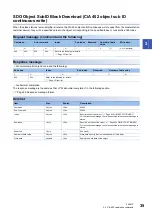
28
3 SLMP
3.1 Description
3
SLMP
3.1
Description
• SLMP (TCP) is not supported.
• When multiple master stations send commands to a single servo amplifier, some commands may not be
received if the interval of sending commands is too short. When the servo amplifier does not respond to
commands, lengthen the interval of sending them.
SLMP (SeamLess Message Protocol) is a common protocol which enables seamless communication among applications
across the network. SLMP communications can be performed for external devices, such as a programmable controller, a
personal computer, and HMI, that can send and receive messages by using SLMP control procedures. The MR-J4-_GF_(-RJ)
servo amplifier is compatible only with the binary code. It is not compatible with the ASCII code.
For the compatibility of SLMP with external devices, refer to manuals for external devices.
In SLMP, a command that a master station (external device) sends to slave stations (servo amplifiers) is called a request
message, and a command that the slave stations (servo amplifiers) send back to the master station (external device) is called
a response message.
When the servo amplifier receives the request message, it returns the response message to the external device after the
servo amplifier response time.
The external device cannot send the next request message until it completes receiving the response message.
*1 The servo amplifier response time differs depending on the command to be sent.
Master station (external device)
Request
message
Request
message
Slave station (servo amplifier)
Response
message
Response
message
Servo amplifier response time
*1
















































